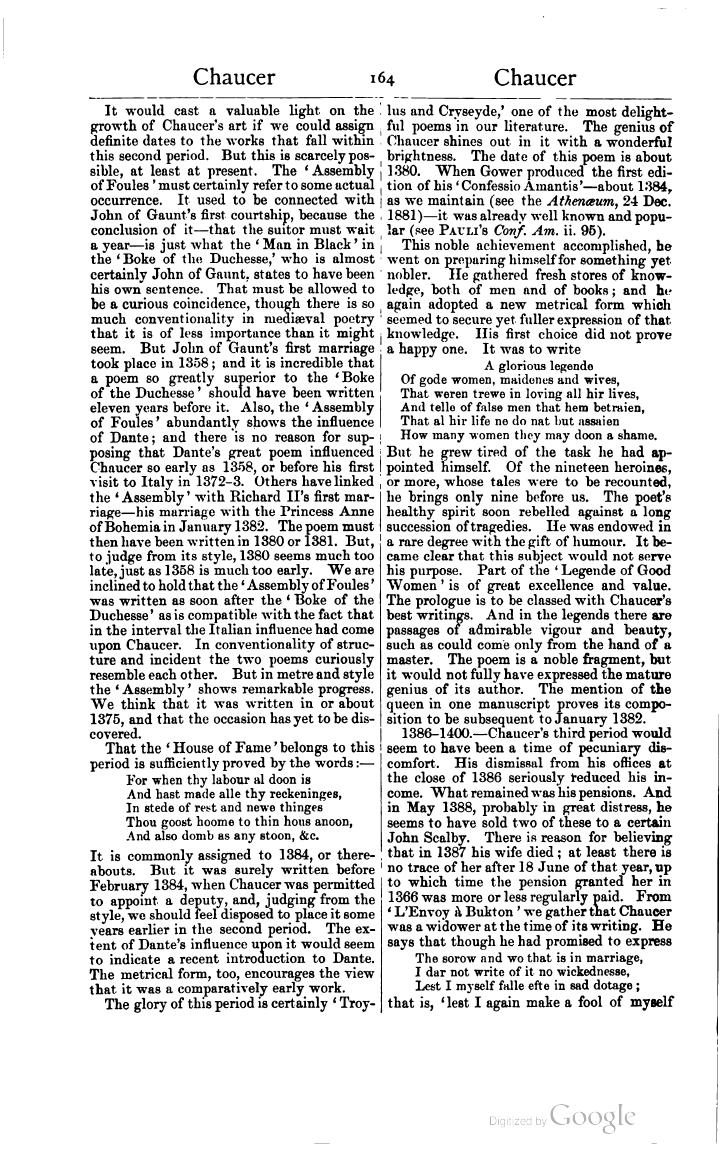It would cast a valuable light on the growth of Chaucer's art if we could assign definite dates to the works that fall within this second period. But this is scarcely possible, at least at present. The 'Assembly of Foules' must certainly refer to some actual occurrence. It used to be connected with John of Gaunt's first courtship, because the conclusion of it — that the suitor must wait a year — is just what the 'Man in Black' in the 'Boke of the Duchesse' who is almost certainly John of Gaunt, states to have been his own sentence. That must be allowed to be a curious coincidence, though there is so much conventionality in mediæval poetry that it is of less importance than it might seem. But John of Gaunt's first marriage took place in 1358 ; and it is incredible that a poem so greatly superior to the 'Boke of the Duchesse' should have been written eleven years before it. Also, the 'Assembly of Foules ' abundantly shows the influence of Dante; and there is no reason for supposing that Dante*s great poem influenced Chaucer so early as 1358, or before his first visit to Italy in 1372-3. Others have linked the 'Assembly' with Richard II's first marriage — his marriage with the Princess Anne of Bohemia in January 1382. The poem must then have been written in 1380 or 1381. But, to judge from its style, 1380 seems much too late, just as 1358 is much too early. We are inclined to hold that the 'Assembly of Foules' was written as soon after the 'Boke of the Duchesse' as is compatible with the fact that in the interval the Italian influence had come upon Chaucer. In conventionality of structure and incident the two poems curiously resemble each other. But in metre and style the 'Assembly' shows remarkable progress. We think that it was written in or about 1375, and that the occasion has yet to be discovered.
That the 'House of Fame' belongs to this period is sufficiently proved by the words : —
For when thy labour al doon is
And hast made alle thy reckeninges,
In stcde of rest and newe thinges
Thou goost hoome to thin hous anoon,
And also domb as any stoon, &c.
It is commonly assigned to 1384, or there-abouts. But it was surely written before February 1384, when Chaucer was permitted to appoint a deputy, and, judging from the style, we should leel disposed to place it some years earlier in the second period. The extent of Dante's influence upon it would seem to indicate a recent introduction to Dante. The metrical form, too, encourages the view that it was a comparatively early work.
The glory of this period is certainly 'Troylus and Cryseyde,' one of the most delightful poems in our literature. The genius of Chaucer shines out in it with a wonderful brightness. The date of this poem is about 1380. When Gower produced the first edition of his 'Confessio Amautis' — about 1384, as we maintain (see the Athenæum, 24 Dec. 1881) — it was already well known and popular (see Pauli's Conf. Am. ii. 95).
This noble achievement accomplished, he went on preparing himself for something yet nobler. He gathered fresh stores of knowledge, both of men and of books ; and he again adopted a new metrical form which seemed to secure yet fuller expression of that knowledge. His first choice did not prove a happy one. It was to write
A glorious legende
Of gode women, maidencs and wives,
That weren trewe in loving all hir lives.
And telle of false men that hem betraien,
That al hir life no do nat but assaien
How many women thoy may doon a shame.
But he grew tired of the task he had appointed himself. Of the nineteen heroines, or more, whose tales were to be recounted, he brings only nine before us. The poet's healthy spirit soon rebelled against a long succession of tragedies. He was endowed in a rare degree with the gift of humour. It became clear that this siibject would not serve his purpose. Part of the 'Legende of Good Women' is of great excellence and value. The prologue is to be classed with Chaucer's best writings. And in the legends there are passages of admirable vigour and beauty, such as could come only from the hand of a master. The poem is a noble fragment, but it would not fully have expressed the mature genius of its author. The mention of the queen in one manuscript proves its composition to be subsequent to January 1382.
1386-1400.— Chaucer's third period would seem to have been a time of pecuniary discomfort. His dismissal from his offices at the close of 1386 seriously reduced his income. What remained was his pensions. And in May 1388, probably in great distress, he seems to have sold two of these to a certain John Scalby. There is reason for believing that in 1387 his wife died ; at least there is no trace of her after 18 June of that year, up to which time the pension granted her in 1366 was more or less regularly paid. From 'L'Envoy à Bukton' we gather tiiat Chaucer was a widower at the time of its writing. He says that though he had promised to express
The sorow and wo that is in marriage,
I dar not writ« of it no wickeduesse,
Lest I myself falle efte in sad dotage ;
that is, 'lest I again make a fool of myself
